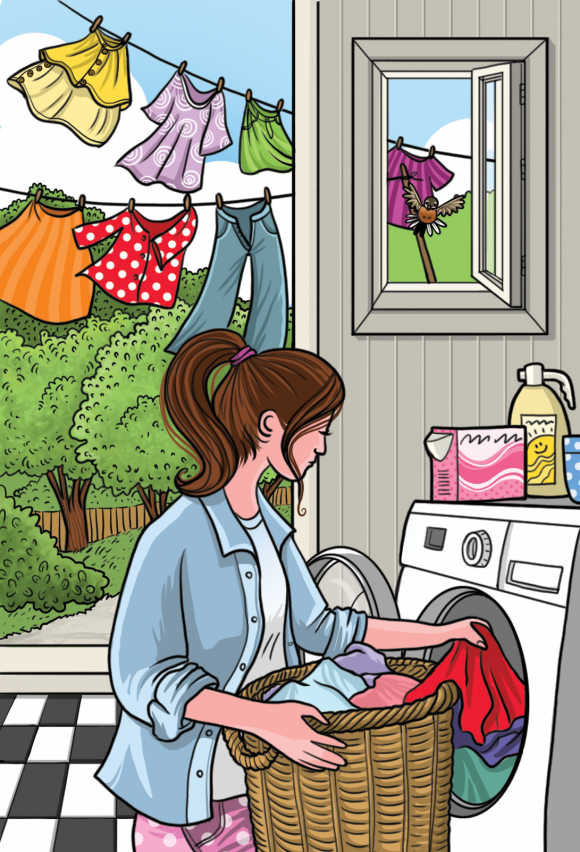In Your Home

| Indoor Water Action | Useful as climate adaption | As emission mitigation |
|---|---|---|
Inside the house. Mostly use the shower rather than running a daily bath. Install and use low-flush or dual-flush toilet cisterns when possible.
Find out how much water your home uses: https://www.smartwatermark.org/watercalculator/NZ/ More ideas for water saving from Consumer NZ: https://www.consumer.org.nz/articles/how-to-save-water-using-your-appliances | Water use efficiency reduces demand on river and groundwater flows, leaving more for nature. Subsequently, the reduced input cuts outputs of wastewater volume sent to sewage works for treatment and discharge. Rainstorms can disrupt water supply and treatment, particularly when sediment is washed into the water which affects disinfection processes. Rain from your roof must not enter sewage systems as they can become overloaded. Keep pipes separate, as required in the Building Consent. | Taking fewer baths and shortening showers from 10 down to 5 minutes could save 180kg of CO2e emissions in a year from water heating, if you burn gas to heat the water. Less emissions if you use an electric heat pump for water heating. Advice on saving water volume and heating costs/emissions: https://www.building.govt.nz/getting-started/smarter-homes-guides/water-and-waste/efficient-use-of-water Your efficiency brings a small power saving in Council water supply and treatment systems. This also helps reduce demand to expand water infrastructure, with its high embodied-carbon costs (in plastic pipes, concrete, fuel for excavators, etc). |
| Electricity Investment | Useful as climate adaptation | As emission mitigation. |
Consider renewable power generation (especially solar PV panels) with electricity storage batteries.
| If you have PV panels plus battery installed, it can help with home or business power continuity when network sources are disconnected by storm damage. The payback time on capital investment in PV systems from reduction in power bills is quite long. | Carbon savings only achieved when solar panels are substituting for generation of your electric power by coal, oil or gas burning, which tends to be used at peak demand times such as early evening or in mid-winter: so, it would mostly be the battery that reduces carbon emissions. NZ Climate Commission is recommending decarbonisation of electricity generation. https://www.rnz.co.nz/news/national/504568/save-2b-a-year-by-cutting-carbon-climate-change-commission-tells-government |
Look for energy (and water) efficiency labels when replacing appliances. Seek the highest star Energy Rating Labels for super-efficient appliances. As an example, a front-loading washing machine uses less water and less energy than a top-loader. Useful guide to smarter appliance shopping: https://genless.govt.nz/stories/your-checklist-for-smarter-appliance-shopping/ | High efficiency appliances reduce lifetime use of power (and water). The extra purchase cost is usually re-paid over time by lower running costs. Read more about which appliances have efficiency labels: https://www.eeca.govt.nz/regulations/equipment-energy-efficiency/about-energy-rating-labels/ | |
When renewing equipment at home: to reduce emissions, avoid LPG gas, oil and coal for water and room heating, or cooking. Replace oldest fridges and freezers, use heat pumps for water and/or room heating. Use smart thermostats for control of heating input to when and where you need it. Do not run a summer fridge in a hot outdoor shed or garage. | Your efficiency helps avoid power cuts: Reduce cumulative stress on the power supply grid at peak demand times around breakfast and dinner. This aids power network resilience, which is particularly stressed in hottest weather, snow or wind-storm conditions. Alpine Energy can advise you on safe practices in tree trimming near power lines: https://www.alpineenergy.co.nz/customers/tree-management | Reduced electricity demand over the appliance lifetime in use means a smaller carbon footprint and lower cost to run, even if it initially costs more to buy. See independent reviews of appliance efficiency at the Consumer NZ website (monthly subscription) or the magazines held by libraries. Electric cooking results in 50% less carbon emissions per meal than cooking with gas. |
Energy-efficient lighting. LED bulbs and strip-lights are 85% more efficient lighting than incandescent bulbs and 60% better than compact fluorescent bulbs. https://genless.govt.nz/for-everyone/at-home/use-led-lighting/ Whatever the bulb type, turn off lights when not required. Consider automatic movement detectors for outside or corridor lights. Darkness outside the house overnight is kinder to wildlife too. | Reduces peak load stress, increasing resilience of the network, as above. | Even at higher purchase price, the LED lights will pay for themselves in power savings as well as generating fewer emissions. |
Last updated: 04 Jun 2024